List of equipment of the British Army
This is a list of equipment of the British Army currently in use. It includes current equipment such as small arms, combat vehicles, explosives, missile systems, engineering vehicles, logistical vehicles, vision systems, communication systems, aircraft, watercraft, artillery, air defence, transport vehicles, as well as future equipment and equipment being trialled.
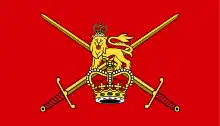 |
| British Army of the British Armed Forces |
|---|
| Components |
| Administration |
| Overseas |
| Personnel |
| Equipment |
| History |
| United Kingdom portal |
The British Army is the principal land warfare force of the United Kingdom, a part of British Armed Forces. Since the end of the Cold War, the British Army has been deployed to a number of conflict zones, often as part of an expeditionary force, a coalition force or part of a United Nations peacekeeping operation.[1]
To meet its commitments, the equipment of the Army is periodically updated and modified. Programs exist to ensure the Army is suitably equipped for both current conflicts and expected future conflicts, with any shortcomings in equipment addressed as Urgent Operational Requirements (UOR), which supplements planned equipment programmes.[2]
Infantry section equipment
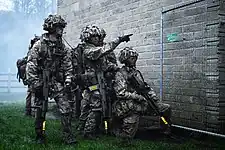
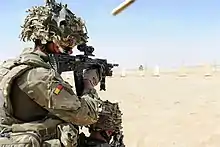
Each rifle section typically consists of 8 soldiers. They are each commanded by a corporal assisted by a lance corporal acting as section second-in-command (2IC). The section is further subdivided into 2 fireteams. The section commander typically commands the Charlie Fire Team, while the 2IC commands the Delta Fire Team.
While equipment formations can be tailored as required by section and platoon commanders, infantry sections are usually issued with the following: [3][4]
- Charlie Fire Team (4 men)
1× Section Commander, Corporal (OR-4), armed with 1 L85A3 rifle and 1 Glock 17 pistol
1× Rifleman, Private (OR-1), armed with 1 L85A3 rifle
1× Grenadier, Private (OR-1), armed with 1 L85A3 rifle and 1 L123A2 under-barrel grenade launcher
1× Sharpshooter, Private (OR-1), armed with 1 L129A1 Sharpshooter rifle
- Delta Fire Team (4 men)
1× Second-in-Command, Lance Corporal (OR-3), armed with 1 L85A3 rifle and 1 Glock 17 pistol
1× Rifleman, Private (OR-1), armed with 1 L85A3 rifle
1× Grenadier, Private (OR-1), armed with 1 L85A3 rifle and 1 L123A2 under-barrel grenade launcher
1× Machine Gunner, Private (OR-1), armed with 1 L7A2 general-purpose machine gun
The rifles are typically paired with the ELCAN SpecterOS 4× Lightweight Day Sight (LDS) with a mini-red dot sight (MRD) mounted on top.
The section is also authorized 1 MATADOR anti-structure recoilless rifle and 1 NLAW disposable ATGM, as well as multiple L109A2 high explosive grenades, and L83A1 smoke grenades.
Specialist equipment such as claymore mines, L26A1 bangalore torpedoes, L128A1 combat shotgun, etc, can be carried if required.
Vision systems
- Sight Unit Small Arms, Trilux (SUSAT) or SpecterOS Lightweight Day Sights (LDS) - for use with the SA80.[5]
- Advanced Combat Optical Gunsight (ACOG) - to be used with the L129A1 Sharpshooter.[6]
- ARILLS (Assault Rifle In-Line Low Light Sight) - new infrared / thermal imaging sight for the SA80 A3.
- Laser Light Module (LLM Mk3) - used for aiming and illumination with the SA80 A3. [7]
- Jim Compact Sight - new infared binoculars that can spot targets from more than 5km away, have both thermal and low-level light capabilities and can take HD pictures and video recordings. It also has a laser positioning system.[8]
- Magnum Universal Night Sight (MUNS) - high-resolution clip-on night vision weapon sight for the L129A1 Sharpshooter. Detects and recognizes man-size targets in excess of 800 meters. [9]
- FIST Thermal Sight (FTS) - thermal imaging scope designed to be mounted on rifles and light machine guns. Acquired as part of the MoD's Future Integrated Soldier Technology. [10]
- Common Weapon Sight (CWS) - image-intensification night vision scope for weapons or handheld surveillance.[11]
- Head mounted Night Vision System (HNVS), based on the American AN/PVS-14.[12]
- Schmidt & Bender 5-25x56 PM II - 25x magnification day scope for the L115A3 Sniper Rifle. [13][14]
- Sniper Thermal Imaging Capability (STIC) - thermal imagining sight that is mounted on the L115A3 and AX50.[15]
- The command launch unit (CLU) of the Javelin anti-tank missile contains a sophisticated thermal imaging sensor that can double as a reconnaissance tool. [16]
Communications equipment
- Personal Role Radio (PRR) [17] - small, light UHF radio with a range of 500m and a battery life of 20 hours, issued to every member of the Infantry section.[18]
- Bowman Combat Net Radio - secure HF, VHF, UHF voice and data communications. The MoD plans to replace Bowman with a system named Morpheus in the future.[19]
- Falcon - joint tactical trunk communications system for the Land Environment.[20]
- Reacher - is a mobile X-Band Satellite Ground Terminal that uses the Skynet V military satellite network
- Small SATCOM - the satellite ground terminal is reasonably lightweight (41 kg) and can be set up by a single trained operator in less than 30 minutes, also using the Skynet V network.[20]
- Skynet - is a family of military communications satellites, they provide strategic and tactical communication services to the branches of the British Armed Forces, the British intelligence agencies, some UK government departments and agencies, and to allied governments including the Five Eyes intelligence alliance members (Australia, Canada, New Zealand, the United Kingdom and the United States).
- Tactical Satellite Communications (TACSAT) - use low orbiting communications satellites to relay radio signals between operators. The advantage to this method is the ability to communicate in remote areas out of reach of terrestrial transmitters.
Weapons
Pistols
| Name | Origin | Type | Cartridge | Image | Details |
|---|---|---|---|---|---|
| Glock 17 (L131A1), Glock 19 (L137A1)[21] | Semi-automatic pistol | 9×19mm |  |
Adopted as the new standard issue sidearm to replace the L9A1 pistol, the L47A1 pistol, and the L105A1/A2, L106A1, L107A1, and L117A1/A2 pistols.[22] The L131A1 is a double action sidearm used for close combat with a magazine capacity of 17 rounds;[23][24] where deemed appropriate, it is the primary weapon of personnel working in operational staff appointments and vehicle commanders and carried as a backup weapon by frontline personnel.[25] The pistol is much lighter than its predecessors and more accurate. It also has an increased magazine capacity. Over 25,000 were purchased for use by all branches of the British Armed Forces.[26] The compact Glock 19 variant was also adopted.[21] |
Infantry rifles
| Name | Origin | Type | Cartridge | Image | Details |
|---|---|---|---|---|---|
| L85A2, L85A3, L22A2 | Assault rifle (L85A2/A3) Carbine (L22A2) |
5.56×45mm |  _MOD_45160295.jpg.webp) |
Standard issue assault rifle, known as the 'SA80', with an effective range of 300 to 600 m (980 to 1,970 ft). Primarily fitted with either SUSAT, ACOG, Elcan SpecterOS 4X or Thermal Viper 2 sights. The Laser Light Module Mk3 and the L123 Underslung Grenade Launcher (UGL) can also be attached.[7][27]
A shortened carbine variant, the L22A2, is used primarily by vehicle and helicopter crews for self-defence and by dog handlers.[28] On 11 April 2016,[29] the MoD announced the L85A3 upgrade programme to extend the life of existing weapons to 2025 and beyond, with changes including upper receiver modifications, a new model of railed handguard to provide a full-length rail system, and a Flat Dark Earth coating for improved camouflage. An initial quantity of 5,000 rifles was upgraded to the new L85A3 standard, with further tranches being upgraded on an ongoing basis.[30] | |
| L119A1, L119A2 | Carbine (Officially designated and treated as a rifle) | 5.56×45mm | 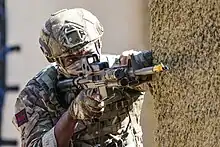 |
The C8 Carbine is used by; the Special Air Service,[31]16 Air Assault Brigade's Pathfinder Platoon,[32] 1st Battalion, Parachute Regiment and other Army components of the Special Forces Support Group,[33] the Royal Military Police Close Protection Unit,[34] and the Ranger Regiment.[35]
The L119A1 is also used by the Army component of 3 Commando Brigade after the Royal Marines began to use it as a replacement for their L85A3s.[36][37] An A2 variant was developed for United Kingdom Special Forces use,[21][38] while other units continue to employ the A1 version. [39] | |
| L129A1, L129A2 | Sharpshooter rifle | 7.62×51mm | 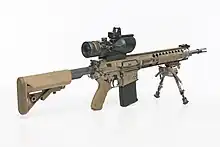 |
The Sharpshooter is the primary designated marksman rifle, equipped with an ACOG optical sight for long-range engagements.
There is also a Sniper Support Weapon version fitted with a 12x Schmidt & Bender scope and a suppressor for use by the second man in each sniper team.[40][41] | |
| L403A1 | Assault rifle | 5.56×45mm | Chosen to serve as the Alternative Individual Weapon of the Ranger Regiment and other Army Special Operations Brigade components, the L403A1 is the Knight's Stoner 1 variant of the Knight's Armament Company SR-16 fitted with a muzzle signature reduction system to mask the weapon from detection and a magnified optic. The rifle's barrel is dimpled, cold hammer-forged, and free-floating, while the handguard covers almost the entire barrel length to provide additional protection (to the barrel from damage, and to the firer from the barrel when it gets hot) and to allow attachment of ancillary equipment without compromising the firer's grip on the rifle. An initial order of 1,620 systems has been placed, with an option to procure up to 10,000 systems over the next decade.[42][43] |
United Kingdom Special Forces have been known to operate a wide variety of weapons such as the M4 carbine UCIW, M16 rifle, HK G3, HK33/53, HK G36C, HK417, Sig Sauer MCX, but their primary rifle is the C8 carbine.
Bladed weapons
| Name | Origin | Type | Image | Details |
|---|---|---|---|---|
| L3A1 | Socket bayonet | .jpg.webp) |
The L3A1 bayonet has a hollow handle that fits onto the muzzle of the L85 rifle with the blade offset to the side so that the rifle can be fired while the bayonet is fitted. It is shaped to produce good penetration when thrust and has a ribbed section for rope cutting. The bayonet can be used as a knife when needed. The L3A1's scabbard features a saw blade for use on wood, a sharpening stone and a bottle opener. The scabbard and bayonet can be combined to form a wire cutter.[44][45][46]
A rail-mounted adaptor was developed to allow the bayonet to be used with the L129A1 Sharpshooter Rifle.[47] | |
| Kukri | Fighting-utility knife |  |
The Kukri is in service with the Brigade of Gurkhas in the British Army. [48] |
Long range rifles
| Name | Origin | Type | Cartridge | Image | Details |
|---|---|---|---|---|---|
| L115A3, L115A4 | Long range rifle | 8.6x70 mm (.338 Lapua Magnum) |  |
The Accuracy International AWM (known in British service as the L115A3/4) is the primary precision rifle for British Armed Forces snipers. It is equipped with a 25x scope, a suppressor, a folding stock, a five-round .338 Lapua Magnum magazine and has an effective range of over 1,100m.[49] An updated L115A1, the L115A3 entered service with British forces in 2008. The A3 features a detachable sound suppressor, all-weather day sights with improved magnification, as well as the provision for mounting night sights.
Special Forces users of the L115A3 had a requirement to fire a 300 gr (19 g) bullet - heavier than the 250 grain earlier L115s were built for - which resulted in Accuracy International developing the A4 model. It features a lengthened magazine and magazine well that can accommodate a 300 grain round, as well as a new keymod mounting system on the handguard and the addition of a spirit level at the rear of the receiver.[50] The L115A3 was developed as part of the Sniper System Improvement Programme (SSIP) to replace the Accuracy International Arctic Warfare (L96) and Accuracy International AWM (L115A1) sniper rifles. [51] | |
| AI AX50 | Long range rifle | 12.7x99 mm |  |
Long range standalone .50 BMG anti-material rifle that is based on and replaced the AW50.[52] | |
| Barrett M82 (L135A1) | Anti-materiel rifle | 12.7x99 mm |  |
Recoil-operated, semi-automatic, anti-material rifle. The British Army uses the M82A1 under the L135A1 Long Range Precision Anti-Structure (LRPAS) Rifle designation.[53][21] |
Submachine guns
| Name | Origin | Type | Cartridge | Image | Details |
|---|---|---|---|---|---|
| L92A1 L91A1 L80A1, L90A1 |
Submachine gun | 9×19mm |  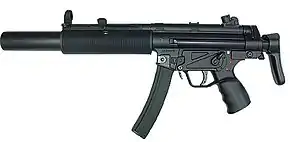 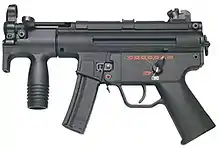 |
Used by UKSF and the Royal Military Police Close Protection Unit.[54] The weapon comes in multiple variants from the standard L92A1 (MP5A3) and the integrally-suppressed L91A1 (MP5SD3) to the more easily concealable L80A1 (MP5K) and L90A1 (MP5KA1) which are stockless and have vertical foregrips.
The weapons no longer see extensive use but are retained for hostage rescue operations in non-hostile environments since their 9x19mm ammunition is less likely to ricochet or over-penetrate.[55] |
Machine guns
| Name | Origin | Type | Cartridge | Image | Details |
|---|---|---|---|---|---|
| L7A2 | General-purpose machine gun | 7.62×51 mm |  |
The designated general purpose machine gun (GPMG) for sustained fire out to 1,800 m. It is used by two-man teams in specialised machine gun platoons for battalion-level fire support;[56] it is also carried by a foot soldier in an infantry section and was reinstated as the standard section machine gun following the removal of the L110A3 Minimi from service.[57]
Variants of the GPMG are mounted on most ground vehicles within the British Army.[58] | |
| L1A2, L111A1 | Heavy machine gun | 12.7x99 mm |  |
The L1A2[59] and L111A1 are the British Armed Forces versions of the American M2 Browning. It can be attached to both armoured and soft-skin vehicles, or a ground-mount tripod.
The weapon fires .50 calibre rounds at a rate of 485-635 rounds-per-minute out to an effective range of 2,000 metres.[60] |
Shotguns
| Name | Origin | Type | Cartridge | Image | Details |
|---|---|---|---|---|---|
| Benelli M4 Super 90 L128A1[61][62] |
Semi-automatic shotgun | 12 bore | .jpg.webp) |
Standard issue combat shotgun used in certain scenarios such as compound clearing, by an infantry section's point man.
The L128A1 has a capacity of eight rounds and a maximum effective range of 140 m (460 ft) for solid shot and 40 m (130 ft) for buckshot.[63] | |
| Remington 870 L74A1, L74A2[21] |
Pump-action shotgun | 12 bore |  |
The Remington 870 pump-action shotgun is used by the SAS during counter-terrorist operations. [64]
The SAS use special Hatton rounds to shoot hinges and locks off of locked doors. The Hatton round is a mixture of compressed gun or zinc powder and wax and is formulated to cause only localised damage without passing through the door and hitting a hostage. [65] |
Grenade launchers
| Name | Origin | Type | Cartridge | Image | Details |
|---|---|---|---|---|---|
| Heckler & Koch AG36 (L123A2, L123A3) Heckler & Koch AG-C/EGLM (L17A1) |
Underslung grenade launcher | 40×46 mm | _MOD_45160296.jpg.webp) |
Variant of the AG36 grenade launcher introduced during the SA80A2 upgrade and issued on a scale of two per infantry section.[66][57] [67][68]
Ammunition natures used include fragmentation, HEDP, white illuminating parachute, infra-red illuminating parachute, and red phosphorus.[45][46][69] The L17A1 version is used with the L119A1/A2 rifles.[70] | |
| Heckler & Koch GMG (L134A1) |
Grenade machine gun | 40×53 mm |  |
The L134A1 is used for the suppression of enemy infantry and can be mounted on both armoured vehicles and tripods. It combines the advantages of a heavy machine gun and a mortar in one; delivering a high rate of fire with fragmentation effect. The weapon has a 320 rpm rate of fire and an effective range of 1,500 m (4,900 ft)-2,000 m (6,600 ft).[71] |
Explosives
| Name | Origin | Type | Detonation | Image | Details |
|---|---|---|---|---|---|
| L109A2[72] | HE hand grenade | Fuse | 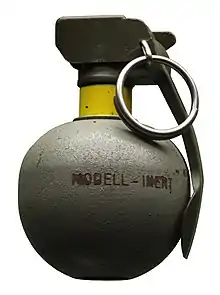 |
British version of the Swiss HG 85 Grenade. It differs from the original in that it has a matte black safety clip similar to the American M67 grenade. It has a 3–4 second fuse delay (climate dependent), contains 155g of high explosive and has an effective casualty radius of 15 m (49 ft).[73] | |
| L83A1/A2, L132A1 | Smoke screening hand grenade | Fuse |  |
Used for concealing unit movements when executing manoeuvres or withdrawing.[74] | |
| L84A3[75] | Red phosphorus smoke screening hand grenade | Fuse | _(52836075387)_(L84A3_crop).jpg.webp) |
Red phosphorus smoke grenade which is effective against visual sight and aiming equipment, night-vision devices, sensors operating in the near IR-spectrum and laser range finders.[76] | |
| L68A1 Green/L69A1 Orange/L70A1 Red/L71A1 Blue/L100A1 Yellow/L101A1 Purple/L152A1 Green/L153A1 Orange/L154A1 Red/L155A1 Yellow/L157A1 Purple/L158A1 Turquoise. | Signal smoke hand grenade | Fuse | 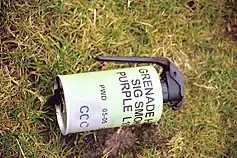 |
Used for ground-to-ground and ground-to-air signalling and for marking target and landing zones, evacuation points, airdrop positions, etc.[74]
The colours in use are Green, Orange, Red, Blue, Yellow, Purple, Turquoise. The various colours of smoke created by smoke grenades do not have preassigned meanings or uses. The specific meaning of a given colour is determined by the needs of the user at the time of use. | |
| M18A1 Anti-Personnel Mine[77] | Command-detonated anti-personnel mine | Remote | 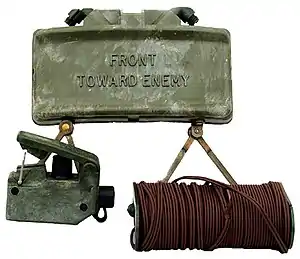 |
Used for specialist and defensive purposes.[78] The Claymore fires steel balls out to about 100 m (110 yd) within a 60° arc in front of the device. It is used primarily in ambushes and as an anti-infiltration device against enemy infantry. It is also used against unarmored vehicles. | |
| L26A1[79] | Bangalore torpedo demolition charge | Detonator | 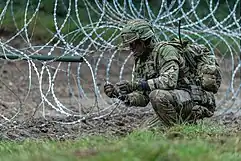 |
The L26A1 was chosen to fulfill a MOD requirement for an improved bangalore torpedo design, and is lighter and easier to use than its predecessors.
The torpedo consists of an aluminium body filled with two kilograms of DPX1 explosive; detonation produces enhanced blast and fragmentation effects which in turn provide an enhanced cutting capability against both simple and complex wire entanglements. The L26A1 is also capable of cutting through up to six millimetres of steel plating. Up to eight L26A1s can be combined with one another, with the resulting assembly capable of defeating obstacles that are up to eight metres in length.[80][81][82] | |
| PE7, PE8 | Plastic explosive (RDX-based) | Detonator | Replacements for the long-serving PE4 plastic explosive. [83] PE7 was developed from Eurenco's HEXOMAX explosive[84] and is available in 500g block (L20A1) and 2 kg slab (L21A1) forms.[85][86] PE8 was developed by Chemring and is available in 2 kg slab (L22A1) form only.[87] Both PE7 and PE8 slabs are issued in a 20 kg logistic pack containing two 10 kg bulk packs that have five 2 kg slabs each, with the 10 kg packs being capable of use for demolitions as a complete unit; the 2 kg slabs themselves contain four 500g blocks (designated L23A1 in the case of PE8 slabs) that can be removed and used individually.[88][89] | ||
| L9A8, L17A1, L18A1[90] | Anti-tank mine, demolition charge (improvised) | Pressure or detonator |  |
Primary anti-tank mine. During the Gulf War, it was found to be highly resistant to mine ploughs, simply rotating under it to detonate below the vehicle, disabling some M60 tanks of the USMC after Iraq captured L9s from the Kuwaiti Army.[91] During Operation Herrick, barmines were split in half for use as improvised demolition charges.[92] | |
| L1A1[87] | Conical and linear demolition charges | Detonator | User-filled plastic explosive containers that have replaced pre-prepared demolition charge variants in British service due to their lower cost (both in terms of acquisition and in terms of storage since unfilled containers can be stored indefinitely[93][94] while charges such as the L1A1 Necklace Charge had a shelf life of ten years[95]) and their improved safety and ease of use.[96] Both containers consist of a plastic body with a copper lining (with the conical container also including four wooden legs for an adequate standoff distance) and can be used in wet conditions without any reduction in effectiveness unless a body of water is present between the underside of the copper lining and the target; the conical container is filled with 12 kg of PE8 prior to deployment and produces a hole in the target,[97][93] while the linear container is filled with 8 kg of PE8 and produces a linear cut in the target.[98][94] | ||
| L23A1[99] | Plastic explosive (RDX-based) | Detonator | Sheet-shaped plastic explosive. The DPX9 composition provides a high level of end-user safety without reducing performance in metal cutting and other tasks.[100] |
Indirect fire weapons
| Name | Origin | Type | Calibre | Image | Details |
|---|---|---|---|---|---|
| L16A2 81mm Mortar | Mortar | 81 mm | 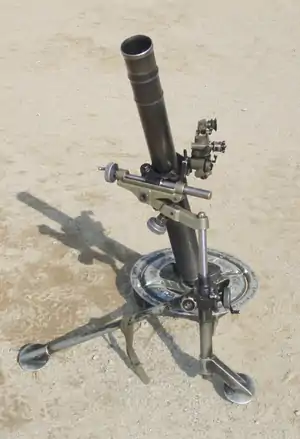 |
Operated by a three-man team. It is often vehicle-borne; in mechanised infantry battalions it is mounted and fired from a Bulldog armoured vehicle.[101] Around 470 are in service.[102]
High Explosive (HE), Smoke and Illumination rounds can be fired up to 5.5 km (3.4 mi) out at a rate of 15 rounds-per-minute. [103] The modernised L16A2 features GPS and laser-range finding systems, dramatically increasing the weapon's accuracy. [104] |
Portable anti-material weapons
| Name | Origin | Type | Warhead | Image | Details |
|---|---|---|---|---|---|
| NLAW | Anti-tank guided missile | 150 mm |  |
Man-portable, short range fire-and-forget anti-tank guided missile system designed for non-expert use. It is designed to "rapidly knock out any main battle tank in just one shot by striking it from above".[105]
In December 2022, it was announced that a £229 million deal had been agreed with Saab for several thousand more NLAW units to be delivered to the British Army from 2024 - 2026.[106] | |
| Javelin | Anti-tank guided missile | 127 mm |  |
Man-portable medium range anti-tank missile system. It fires a high-explosive anti-tank (HEAT) warhead and can penetrate explosive reactive armour.
The Javelin has several modes of flight including direct and an overfly-top-attack mode in which the missile arcs high then flies down onto the top of the target, thus getting around the heavy front armour of modern tanks. Javelin warheads are also highly effective at taking out buildings, bunkers and fixed positions. The Javelin warhead is a 'tandem' configuration : the first shaped charge is designed to penetrate the target's outer defenses, such as reactive armour, whilst the second goes on to do further damage.[107] | |
| MATADOR-AS | Anti-structure weapon | 90 mm | 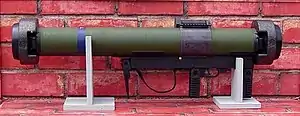 |
Disposable, man-portable guided anti-structure weapon. It is designed to destroy hardened structures, such as bunkers, buildings and other fixed positions.[108] | |
| Carl Gustaf M4 | Recoilless rifle | 84 mm | _(brightened%252C_no_background)_(leveled).png.webp) |
Launchers and training, anti-structure, and anti-tank rounds purchased in order to replenish munition stocks following the constant supplying of NLAW and MATADOR weapons to Ukraine.[109] | |
| L1A2, L2A1 ILAW | Recoilless gun | 84 mm | .jpg.webp) |
The AT4 CS variant is still in use for urban warfare applications, due to having less of a 'back blast'.
It was previously used as an interim replacement for the LAW 80, while the NLAW was being developed.[110][111][112] | |
| Starstreak | MANPADS | 3 darts of 22 mm |  |
Alongside the LML and Stormer mounted versions, the Royal Artillery also use a shoulder-mounted, man-portable version of the Starstreak missile.[113]
After launch, the missile accelerates to more than Mach 4, making it the fastest short-range surface-to-air missile in existence. It then launches three laser beam-riding submunitions, increasing the likelihood of a successful hit on the target.[114] | |
| Martlet | Multi-role missile | 76 mm | 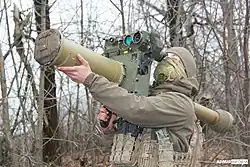 |
Uses the same launchers as the Starstreak missile while being intended for use against a wider range of targets.[115][116] |
Personal equipment

Helmet
All soldiers are now equipped with the new Virtus helmet[117] (Revision Batlskin Cobra Plus[118]) which provides increased blunt impact protection, has a lighter weight than the preceding Mk7, can be fitted with face and mandible guards for certain roles, is specially shaped to allow effective weapon usage while in a prone position and wearing body armour, and features a permanent universal night vision mount and a scalable counterweight attached to the helmet's rear in order to ease strain on the user's neck while a night vision device is equipped. The helmet allows the soldier to wear a respirator, hearing protection, goggles and/or a radio headset as necessary.[119][120]
The previous standard helmet in service was the Mk7 which replaced the older Mk6 and Mk6A helmets on operations.
84,000 Mk 7 helmets were donated to the Armed Forces of Ukraine in 2022.[121]
Combat body armour
The British Army uses two main combat body armour systems;
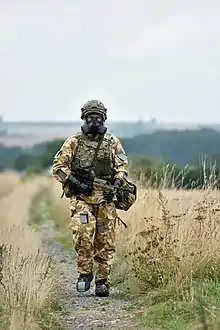
The Virtus Scalable Tactical Vest (STV) is the primary body armour system used on live operations, LFTT, and firing ranges and has replaced the previously used Osprey body armour. It is 10lbs lighter than Osprey and closer-fitting and can have its level of protection more closely scaled to the prevailing threat type. The vest also features a quick-release mechanism to aid safe extraction from hazardous situations such as burning vehicles or drowning and a dynamic weight distribution system which, when linked to a soldier's waist belt, aids in spreading the soldier's load across the back, shoulders, and hips; a mechanism in the small of the back allows the wearer to adjust the weight bias depending on the situation. The STV can be used in a variety of ways including; load carriage without armour, a fragmentation vest with soft composite armour but no hard plates, a plate carrier with no soft armour, and a full body armour system with both soft armour padding and hard plates.[117][120]
Enhanced Combat Body Armour (ECBA)[122][123][124] is a soft body armour vest that was first introduced in the 1980s and can be augmented with ceramic ballistic plates. It was used on operations until the introduction of the Osprey body armour series in 2006 and is now used solely for training purposes, primarily for non-infantry phase one training recruits.
Ancillary to regular body armour is a three-tier pelvic armour system - issued since 2010 - to mitigate against shrapnel and other blast effects. The first layer is a pair of underwear shorts manufactured from a ballistic silk material. The second layer consists of detachable pelvic body armour that is intended to be worn while 'outside the wire' to meet the greater threats faced by soldiers on patrol. The third layer consists of knee-length ballistic shorts worn over a soldier's combat trousers, offering coverage of the upper leg and wider abdominal region and designed for use by soldiers operating hand-held metal detectors to search for explosive devices or otherwise serving in a combat role where greater levels of protection are required.[125][126]
8,450 sets of Osprey body armour were donated to the Armed Forces of Ukraine in 2022.[127]
Respirator
By January 2015, over 300,000 General Service Respirators had been delivered to replace the older S10 respirator.[128]
Features which differentiate it from the S10 which it replaced are:
- Twin filter canisters can be changed more easily while in a CBRN environment
- Single visor give better visibility and reduces the claustrophobic effect
- Improved drinking system
- Ability to convert to EU standard canisters with a simple modification
These respirators are also used by the rest of the British Armed Forces.
Uniforms
The multi-terrain pattern (MTP) combat clothing is designed to blend with the range of environments such as woodland, jungle, compounds, crops, grassland and arid stone. This change to the British camouflage pattern was the first in 40 years. The uniform is flame-retardant and insect-repellent treated.[129]
Troops on operations are issued with bacteria-zapping socks - which are completely waterproof. The knee length socks help to keep troops' feet dry when they are wading through ditches and streams. To keep feet hygienic, they have antimicrobial properties similar to those found in medical dressings. They are also superior to conventional socks, keeping feet warmer during the winter months.
Boots
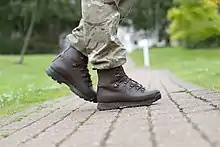
In 2012, the MOD purchased a newly designed range of brown combat boots from Haix,[130] Alt-Berg,[131] and other manufacturers for the Army, Royal Marines and RAF to replace the black and Desert Combat Boot previously worn. Five different types of boots, developed to match the Multi-Terrain Pattern uniform, are available to Armed Forces personnel depending on where they are based and what role they are in. Black boots have been retained for wear with most non-camouflage uniforms as well as units on parade in full dress uniform, such as regiments performing ceremonial duties in central London.[132][133]
- Desert Combat – worn by dismounted troops conducting medium to high levels of activity in desert type environments with temperatures exceeding 40 °C
- Desert Patrol – worn by drivers/armoured troops conducting lower levels of activity in desert type environments exceeding 40 °C
- Temperate Combat – worn by dismounted troops for medium to high levels of activity in temperate (European) climates
- Patrol – worn by mounted troops (drivers/armoured troops) taking part in lower levels of activity in temperate (European) climates
- Cold Wet Weather – worn by dismounted troops for medium to high levels of activity in temperatures down to −20 °C.
The Italian manufacturer AKU now supply their Pilgrim GTX model as an option for a high liability boot alongside Altberg. The Pilgrim GTX Combat Boots are a true multi-purpose highly breathable boot with outstanding support, stability and impact absorption. Thanks to these features, Pilgrim GTX Combat offers great stability for demanding and dynamic conditions. [134]
Personal Role Radio
A Personal Role Radio (PRR) is distributed to every member of an eight-strong infantry section.[17]
It consists of a headset attached to a UHF transmitter/receiver which has 256 channels, a 500m range, 20 hour battery life, weighs 1.5kg, and is effective through thick cover and walls and floors of buildings, increasing the communication and effectiveness of infantry fireteams.[18]
Load carrying equipment


The Virtus webbing system is the current primary load carrying belt system used by the British Army. It consists of a yoke, MOLLE hip belt and dynamic weight distribution (DWD) system, which provides real weight transference, allowing the soldier, while on the move, to shift the weight of the load between 100% on the shoulders to 100% on the hips and anything in-between. The soldier can choose between a variety of pouches to attach to the belt depending on the mission, including grenade, ammo, PRR, UGL, pistol magazine, medical, bayonet scabbard, water bottle, utility, commander's pouch and more.[135][136][137]
Usage of privately purchased webbing, whether based on or customised PLCE or with MOLLE compatibility, also remains a very common item. 'Airborne' webbing, which is a single unit webbing set of multiple pouches sewn or stitched directly onto a foam hip pad[138] is favoured among soldiers for its comfort, stability and durability.[139][140][141]
Personal Load Carrying Equipment (PLCE), officially known as 95 Pattern Webbing, is an older webbing system issued temporarily solely for training purposes during phase 1 'basic' training for non-infantry recruits, to carry ammunition, food and water, protective equipment, and other individual supplies. The webbing consists of a belt, a yoke harness, and various belt pouches. The system also consists of two daysacks (backpacks) for use with the Combat Order; these can be attached to a larger 'Bergen' rucksack for use with the Marching Order.[142] The Osprey body armour and webbing series,[119] the later Virtus scalable tactical vest and webbing,[143] and various items associated with either system such as daysacks all feature MOLLE loops for direct attachment of load carrying pouches, thus obviating the need for and mostly supplanting the earlier PLCE webbing.[120]
PLCE sets have previously been manufactured in the newer MTP camouflage pattern, and both this webbing and earlier DPM webbing (due to the quantity of webbing produced and the durability of its construction and materials, and soldiers personal preference) continues to see occasional usage, particularly during training situations which often see soldiers either wearing the non-MOLLE Enhanced Combat Body Armour vest or wearing no armour at all.[144][145]
Regardless of the particular load carrying system used by any given soldier, Army doctrine prescribes that it should be capable of holding everything that a soldier needs to operate in the field for up to 24 hours without resupply in Fighting Order, for up to 48 hours without resupply in Patrol Order and for up to two weeks without resupply in Marching Order..[146]
Vehicles

Combat vehicles
| Name | Origin | Type | Number | Image | Details |
|---|---|---|---|---|---|
| Challenger 2 | Main battle tank | 227[147] | 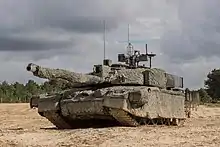 |
Equips three Regular and one reserve (the Royal Wessex Yeomanry) Armoured Regiments of the Royal Armoured Corps.[148]
Challenger 2 is currently being modernised and reduced to 148 upgraded Challenger 3 by 2027.[149][150] Challenger 3 has an all-new turret and new main armament, the smoothbore 120mm L55A1 gun.[151] Challenger 3 will also be equipped with a laser warning system, a Trophy MV active protection system, and have a more powerful engine. [151] | |
| Ajax | Armoured fighting vehicle | 44[147] | 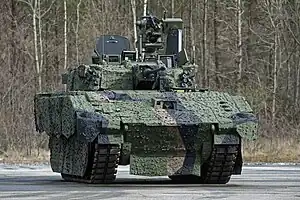 |
Ajax is the replacement for the CVR(T) tracked reconnaissance vehicles and variants.[152]
There are six variants in the Ajax family; Ajax, Athena, Ares, Apollo, Atlas, Argus.[153] Ajax family variants will be used by the Royal Armoured Corps cavalry and Household Cavalry armoured reconnaissance, Royal Artillery fire support teams, armoured Royal Engineers units, and armoured REME units. [153] Ajax is the first British vehicle to be fitted with the Case Telescoped 40mm Cannon. [154] Due to problems with the project, Ajax is still in trial. To be increased to 589 vehicles by 2029.[155] | |
| Boxer | Infantry fighting vehicle | 2 | 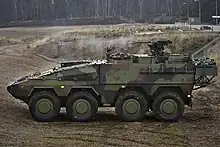 |
Boxer is the new British Mechanised Infantry Vehicle (MIV), an eight-by-eight-wheeled, all-terrain, armoured transport vehicle. The vehicles Remote Weapon Stations will be equipped with a mix of .50 cal heavy machine guns, grenade machine guns and general purpose machine guns. [156]
It will replace the Warrior and Mastiff (and Wolfhound, Ridgeback variants), and will be delivered to;[157]
In total, the Army has ordered 623 Boxers. [158] | |
| Warrior | Infantry fighting vehicle | 625[147] |  |
Equips the battalions of Armoured Infantry in 3rd (UK) Division.
The Royal Armoured Corps Armoured Cavalry & Armoured Reconnaissance Regiments are now using it as a stopgap for combat reconnaisance before the Ajax vehicles reach Initial Operating Capability between July and December 2025, since the retirement of FV107 Scimitar.[159] A small number are also used by the Royal Artillery for command and observation, and by the REME for recovery and repair.[160] The vehicle is to be gradually phased out and replaced by 623 Boxer vehicles from 2023. [161][162] | |
| Bulldog | Armoured personnel carrier | 746[147][163] |  |
FV 430 variants remain in service with the Infantry primarily as 81 mm mortar carriers and command vehicles, while the REME use them as recovery vehicles. [164]
Three Royal Army Medical Corps regiments; 1st Armoured Medical Regiment, 4th Armoured Medical Regiment and 5th Armoured Medical Regiment use an ambulance variant.[165] Bulldog will be replaced by a yet to be determined platform with procurement activity starting in 2025.[166] |
Protected patrol vehicles
| Name | Origin | Type | Number | Image | Details |
|---|---|---|---|---|---|
| Mastiff | Protected mobility vehicle | 329[147] | 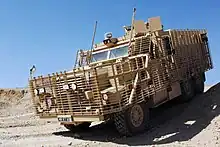 |
Mastiff is a heavily armoured 6×6-wheel drive patrol vehicle which carries eight troops, plus two crew, and is fitted with ECMs and bowman radios.[167]
Ridgeback is a 4×4-wheel drive variant of the Mastiff, and provides protected mobility in urban and urban-fringe environments. It comes in three variants: battlefield ambulance, command variant and troop carrying vehicles.[167] The 6×6 Wolfhound is a tactical support variant of the Mastiff and is used to accompany front line patrols and carry essential combat supplies such as water and ammunition.[168] The vehicles primarily support the Heavy Mechanised Infantry battalions of 3rd (UK) Division and are equipped with either a .50 cal HMG or a 40mm GMG.[169] These vehicles are due to be decommissioned & replaced by the Boxer 'Mechanised Infantry Vehicle'.[170] | |
| Ridgeback | 164[147] | 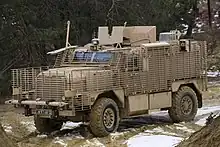 | |||
| Wolfhound | 86[147] |  | |||
| Jackal 2 | Protected mobility vehicle | 431[147] | .jpg.webp) _MOD_45152543.jpg.webp) |
The 4×4 Jackal 2 equips the Light Cavalry regiments of the Royal Armoured Corps, as well as the Light Recce Strike Infantry. [171] The vehicle is an ideal platform for reconnaissance, rapid assault, fire support and convoy protection. The vehicle has a crew of two plus one and a range of 800 km, and has a special air-bag suspension system that allows rapid movement of the vehicle across varying terrain.[172]
Armament includes a 7.62mm GPMG and either a .50-calibre HMG or 40mm GMG as the main weapon system.[172] The 6×6 Coyote is a tactical support variant (TSV) of the Jackal, that allows transportation of supplies and equipment over similar terrain, up to 1.5 tonnes.[173][172] An order for 70 more Jackal 2 and Coyote vehicles was placed in February 2023 with Supacat.[174] | |
| Coyote | 72[147] | ||||
| Foxhound | Protected mobility vehicle | 398[147] |  |
Equips the battalions of Light and Light Mechanised Infantry in 1st (UK) Division and 16 Air Assault Brigade Combat Team,[171] plus resident battalions in Cyprus.[175]
Foxhound is lighter and smaller than other protected vehicles and has a top speed of 70 mph, but can still protect against improvised explosive devices thanks to its v-shaped hull.[176] | |
| RWMIK Land Rover | Protected mobility vehicle | 371[177] | 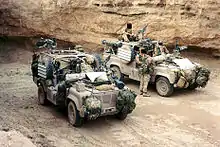 |
The Revised Weapons Mounted Installation Kit primarily equips three Yeomanry (reserve) Light Cavalry Regiments of the Royal Armoured Corps.
All Yeomanry light cavalry regiments are currently undergoing transition from Land Rover RWMIK, to Jackal and Coyote TSV. [178] [179] A small number are maintained as a specialist capability by the Parachute Regiment. | |
| TPz Fuchs | CBRN reconnaissance vehicle | 11[180] | 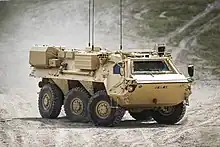 |
Equips Falcon Squadron, 28 Engineer Regiment (C-CRBN), but is manned by soldiers of the Royal Tank Regiment.[181]
In 2022, Supacat delivered the physical integration of the latest chemical, biological, nuclear and radiological sensing equipment, RBSL having completed the engineering work required to upgrade the CBRN vehicles.[182] |
Artillery and Air-Defence
| Name | Origin | Type | Number | Image | Details |
|---|---|---|---|---|---|
| L118 light gun | Towed howitzer | 126[147] |  |
The L118 Light Gun is used by seven field artillery regiments:
1st Regiment RHA, 4th Regiment RA, 7th Parachute Regiment RHA, 29th Commando Regiment RA, 103rd Regiment RA, 104th Regiment RA, 105th Regiment RA. It can be towed by a medium-weight vehicle (such as a Pinzgauer) or carried around the battlefield underslung by the RAF's Chinook helicopters.[183] | |
| AS-90 | Self-propelled artillery | 89[147] | 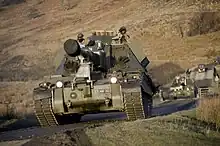 |
The L131 AS-90 is a 155mm self-propelled howitzer and is the largest piece of field artillery in the British Army. The L131 is operated by two field artillery regiments: 1st Regiment Royal Horse Artillery, 19th Regiment Royal Artillery.[184] | |
| Archer Artillery System | Self-propelled artillery | 14[185][186] | .jpg.webp) |
Deal with Sweden announced on 16 March 2023 to replace part of the 32 AS-90 transferred to Ukraine. The ownership is to be transferred before the end of March 2023, and it will be operational from April 2024.[187]
It is announced as an interim replacement before a decision is made regarding the replacement program for the AS-90 that should take place before 2030.[185] | |
| M270 Multiple Launch Rocket System | Multiple rocket launcher | 44[147] |  |
The Guided Multiple Launch Rocket System (GMLRS).
MLRS is to be upgraded to use the Guided MLRS Extended Range (GMLRS-ER) missile and the Precision Strike Missile (PrSM) by 2025, which have ranges of 150 km (93 mi) and 499 km (310 mi), respectively.[188] Operated by the 26th Regiment Royal Artillery, 3rd Regiment Royal Horse Artillery and the 101st Regiment (Reserve) Royal Artillery.[189][190] | |
| Sky Sabre | Surface-to-air missile system |  |
Sky Sabre is the British Army's version of the Common Anti-Aircraft Modular Missile (CAMM), Sky Sabre became operational in January 2022. The system has over three times the range of its predecessor Rapier. The system can control 24 missiles simultaneously and guide them to intercept 24 separate targets. [191]
This system consists of Land Ceptor missiles, SAAB Giraffe AMB radars and Rafael Advanced Defense Systems Modular Integrated C4I Air & Missile Defense System (MIC4AD), all mounted on MAN trucks.[192] Sky Sabre is operated by 16th Regiment Royal Artillery.[193] | ||
| Mobile Artillery Monitoring Battlefield Asset (MAMBA) | Counter-battery radar | _MOD_45148327.jpg.webp) |
It detects enemy artillery projectiles fired by one or more weapons and from their trajectories locates the position of the weapon that fired it. It has a detection range of up to 30 km and can process up to 100 projectiles simultaneously. It is mounted on a Bandvagn 206 (Bv206) all-terrain vehicle.
Operated by 5th Regiment Royal Artillery.[194] | ||
| Counter Battery Radar(COBRA) | Counter-battery radar |  |
COBRA's mission is to locate mortars, rocket launchers and artillery batteries and to provide information for countering their effectiveness. With a detection range up to 100 km, COBRA is capable of locating and classifying up to 40 batteries in two minutes. It can also be able to monitor breaches of ceasefires when deployed in a peace-keeping role.[195]
Operated by 5th Regiment Royal Artillery.[196] | ||
| Starstreak SP HVM | Surface-to-air missile system | 62[180] | 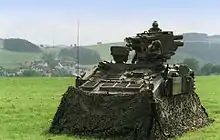 |
The Starstreak SP HVM is mounted on the Alvis Stormer tracked vehicle with an eight-round launcher and internal stowage for a further 12 missiles. The Starstreak HVM (High Velocity Missile) is designed to counter threats from very high performance, low-flying aircraft and fast 'pop up' strikes by helicopters.[197]
Operated by 12th Regiment Royal Artillery and 106th Regiment (Reserve) Royal Artillery.[198][199] | |
| Starstreak LML | Surface-to-air missile system | 145[180] |  |
The Starstreak Lightweight Multiple Launcher (LML) is a short-range, highly mobile air defence system that holds three missiles ready for firing and can be used as either a stationary launch unit or mounted on a light vehicle, such as a Land Rover. Starstreak can also be used as a surface attack weapon, capable of penetrating the frontal armour of IFVs.[197]
Operated by 12th Regiment Royal Artillery and 106th Regiment (Reserve) Royal Artillery.[199][198] | |
| Exactor 2 | Guided missile | 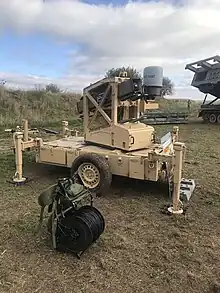 |
Rafael’s Exactor 2 is a new breed of long-range precision-guided weapon that can successfully engage targets at 25-30 kilometres.
The system can be operated automatically, which means that the missile independently guides itself to the selected target without interference (fire-and-forget) or it can be controlled by a human operator (man-in-the-loop) which enables manual control of the missile. [200] Operated by 26th Regiment Royal Artillery.[201] |
Engineering and logistics
| Name | Origin | Type | Number | Image | Details |
|---|---|---|---|---|---|
| Trojan | Armoured engineer vehicle | 32[147] | 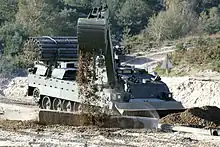 |
Trojan is based on the Challenger 2 chassis and is designed to breach through enemy defences, such as walls or fortifications, and clear paths through minefields. The Trojan is equipped with the Python Minefield Breaching System.[202]
Operated by the Armoured Engineer units of the Royal Engineers, such as 22 Engineer Regiment and 26 Engineer Regiment.[203] | |
| Titan | Armoured vehicle-launched bridge | 33[147] |  |
The Titan is an armoured bridge launcher based on the Challenger 2 chassis with the capability to deploy a bridge up to 60 meters long.[204]
Operated by the Armoured Engineer units of the Royal Engineers, such as 22 Engineer Regiment and 26 Engineer Regiment.[203] | |
| Terrier | Combat engineering vehicle | 56[147] | 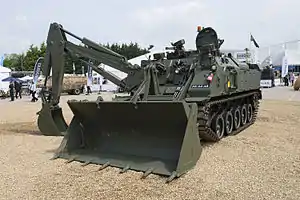 |
Provides mobility support (obstacle and route clearance), counter-mobility (digging of anti-tank ditches and other obstacles) and survivability (digging of trenches and armoured fighting vehicle slots).[205]
Operated by the Armoured Engineer units of the Royal Engineers, such as 22 Engineer Regiment and 26 Engineer Regiment.[203] | |
| CRARRV | Armoured recovery vehicle | 75[177] | _(7527707880).jpg.webp) |
Based on the Challenger 1 chassis and is designed to recover and repair damaged or incapacitated Challenger 2 tanks, but is also powerful enough to recover other heavy armoured vehicles such as the AS-90.[206][207]
An unspecified number of CRARRVs have been donated to the Ukrainian Ground Forces alongside a squadron of Challenger 2 tanks in 2023. [208] Operated by 'Recovery Mechanics' from the Royal Electrical and Mechanical Engineers.[209] | |
| Oshkosh HET | Heavy equipment transporter | 182 [147] | .jpg.webp) |
The Oshkosh HET 1070F is the Heavy Equipment Transport System (HET) of the British Army. The Heavy Equipment Transporters are capable of carrying a 72-tonne main battle tank and are responsible for the strategic transportation of armoured vehicles over land.[210]
Operated solely by 19 Tank Transporter Squadron, RLC.[211] | |
| MTVR | Close support tanker | 354[212] |  |
The Oshkosh Wheeled Tanker forms the backbone of the British Army's bulk fuel and water transportation. The tanker can be fitted with enhanced blast-proof armour for driver protection and General Purpose Machine Guns. [213] | |
| Alvis Unipower | Tank bridge transporter | 139[177] |  |
The Tank Bridge Transporter (TBT) has the same cross-country performance as a tank even when fully loaded. It can carry a No 10 Bridge or 2 × No 12 Bridges (Close Support Bridge) of the BR90 family of bridges. It can deploy, drop off and load bridges independently, but it cannot recover them.[214] | |
| M3 Amphibious Rig | Amphibious bridging vehicle | 27[147] | 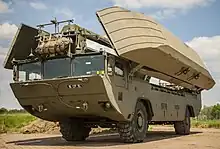 |
The M3 Amphibious Rigs are vehicles operated by a 3-man crew. The M3 Rigs can drive into the water, open up and join together to create a bridge of varying length. A 100m bridge can be constructed using 8 rigs.[215]
Operated by 23 Amphibious Engineer Squadron, RE, based in Sennelager, Germany.[216] | |
| MAN SV | Support vehicle | 6606[147] |  |
The MAN family of support vehicles have gradually replaced all previous cargo vehicles currently in service. Consisting of 6/9/15 tonne variants, 4x4/6x6/8x8 retrospective. They have good mobility and the ability to be fitted with armour and General Purpose Machine Guns.[217]
A total of 382 vehicles were converted in to EPLS Mk.3 systems.[218] | |
| EPLS Mk.3 | Support vehicle | 382 | The Enhanced Pallet Load System (EPLS) is based on the 15-tonne SV variant. It is fitted with additional armour packs to protect crew from ballistic and blast threat and forms the logistic backbone of the British Army. [219]
It is a load carrier with a 15-tonne flatrack payload, allowing the rapid loading and unloading of flatracks or 20 ft ISO containers. [220] | ||
| Pinzgauer | Support vehicle | 190 | 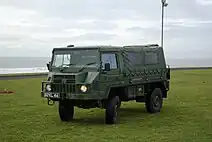 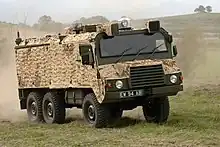 |
The Pinzgauer is a 4×4 and 6×6 tactical support vehicle used by the Royal Artillery and Royal Horse Artillery[221] to tow artillery operated assets, such as the L118 Light Gun and Watchkeeper WK450.[222] | |
| Land Rover Wolf | Light utility vehicle | 6532[147] | 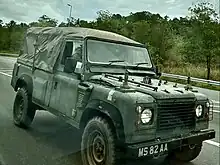  |
The Land Rover Wolf is a militarised version of the Land Rover Defender. They can be found in service with the British Army worldwide, and can be armed with one 12.7mm Heavy Machine Gun and a 7.62mm General Purpose Machine Gun. [223]
The Land Rover Wolf is designated as a Truck Utility Light (TUL – Defender 90) and Medium (TUM – Defender 110). [223] In April 2023, it was announced that British Army Land Rovers will be part of a new trial examining electric power for UK military vehicles. The Armoured Trials and Development Unit (ATDU) will use a series of simulated battlefield scenarios to put the vehicles to the test. [224] | |
| Land Rover Battle Field Ambulance (BFA) | Military ambulance | 116[177] | .jpg.webp) |
The Land Rover Pulse battlefield ambulance has full medical facilities with the capacity to hold up to six seated casualties or four casualties on stretchers. The vehicle can be airlifted.[225] |
Explosive ordnance disposal (EOD)
| Name | Origin | Type | Number | Image | Details |
|---|---|---|---|---|---|
| Dragon Runner | Explosive ordnance disposal | 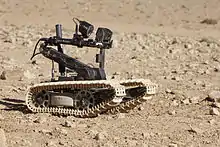 |
Dragon Runner is a lightweight, back-packable, multi-terrain robot capable of detecting a variety of devices without putting the operator in harm's way, which helps bomb disposal experts find and deactivate improvised explosive devices (IEDs). [226] | ||
| L3Harris T7 EOD | Explosive ordnance disposal | 122 | The T7 EOD UGV is equipped with high-definition cameras, lightning-fast datalinks, an adjustable manipulation arm, and tough all-terrain treads, allowing them to neutralise a wide range of explosive threats.
The T7 replaces the previously used Wheelbarrow Mk8B.[227] The robot is purpose-built to operate in extreme conditions and offers support for high-calibre EOD disruptors. Its unique haptic grip controller also provides precision critical to complex tasks, keeping soldiers out of harm’s way, and saving lives.[228][229] | ||
| GASKET 3 | Explosive ordnance disposal | 10 |  |
GASKET 3 is the Heavy EOD response vehicle and carries the T7 bomb disposal RCV and bespoke EOD equipment such as the Mk 6 bomb suit, X-ray equipment and other specialist tools. [230]
The GASKET 3 is based on the Mercedes Benz Atego, extensively modified for Explosive Ordnance Disposal (EOD) and electronic countermeasure (ECM) by Cambridge based Marshall Land Systems. [231] It is used by 11 Explosive Ordnance Disposal and Search (EOD&S) Regiment to provide a nationwide high readiness response capability in support of the police.[232] |
MITER vehicle fleet

The job of the Royal Engineers is to restrict the enemy's ability to advance, while also allowing friendly combat forces the freedom to maneuver as necessary. Other tasks undertaken are bomb disposal, construction of fortifications, runways, roads and bridges and the improvement of existing infrastructure to support operations – such as improving existing roads for logistic convoys. To achieve this, they operate a large and diverse fleet of vehicles. [233]
In August 2020, AmeyBriggs (new joint venture between Amey plc and Briggs Defence)[234] was awarded a seven year, £240m contract to maintain, manage and support the British Army's fleet of earth-moving, engineer construction and mechanical handling capabilities.[235] The C-vehicle Capability, Defence Mechanical Handling Equipment (DMHE), and Protected Engineering Equipment contracts now form part of the new consolidated MITER contract. [236]

AmeyBriggs now provides the British Army with a wide range of earthmoving, construction and materials handling/lifting equipment to support their worldwide training and operational requirements. [237]
In recent years the equipment, which includes excavators, bulldozers, dump trucks, concrete mixers, tractors, lighting towers, forklift trucks and cranes,[238] has been used to help with recovery following the devastation caused by Hurricanes Irma and Dorian in the Caribbean, during major flooding incidents in the UK and supporting the military response to COVID-19 by loading and off-loading vital medical supplies.[239]
All-terrain vehicles
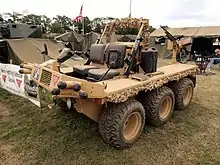
There are a number of all-terrain vehicles in service with the British Army.
The Supacat ATMP is a lightweight 6×6 used by 16 Air Assault Brigade Combat Team.[240] It can carry up to 8 troops with a standard NATO pallet of stores and ammunition.
Approximately 900 Grizzly 450 quad bikes are used as light transport for food, water and ammunition to the front line in difficult to access areas or where larger vehicles are not suitable, effectively moving alongside dismounted troops. They also have the ability to evacuate two casualties at a time, thereby speeding up emergency aid.[241]
United Kingdom Special Forces

UKSF maintain a unique fleet of vehicles to support their operations.
In 2001, 65 Supacat High Mobility Transporter (HMT) 400 vehicles were ordered under Project Minacity after being in development since the late 1990s.[242] The Minacity vehicles entered service in 2003 in Afghanistan.[243] In 2007, the Ministry of Defence ordered the HMT 400 for regular forces known as the Jackal.[242][244]
In 2008, 24 Australian Bushmaster armoured vehicles were purchased for the UKSF for operations in Iraq.[245][246][247] The Bushmasters were fitted with additional armour, counter-IED electronics, and a .50 calibre machine gun mounted in a RWS.[246]
In August 2016, BBC News reported that the Toyota Land Cruiser-based Jankel Al-Thalab long range patrol vehicle was being used in Syria.[248]
Aircraft
| Type | Origin | Class | Role | Introduced | In service | Total | Notes |
|---|---|---|---|---|---|---|---|
| Attack helicopters | |||||||
| AgustaWestland Apache AH1 | United Kingdom | Helicopter | Attack | 2004 | 42 | 50 | [249] To be replaced by 50 AH-64E Apache Guardians in 2024[250] |
| Boeing AH-64E Apache Guardian | United States | Helicopter | Attack | 2022 | 16 | 50 on order | 50 Apache AH1 will be remanufactured to AH-64E specification.[251] |
| Patrol helicopters | |||||||
| Airbus H135M | Germany | Helicopter | Patrol | 2022 | 5 | 30 on order | Project Matcha, Gazelle replacement [252] |
| Westland Gazelle | United Kingdom | Helicopter | Patrol | 1974 | 14 | 17 | [249]OSD October 31st 2023 |
| Transport helicopters | |||||||
| AgustaWestland AW159 Wildcat | United Kingdom | Helicopter | Utility | 2014 | 26 | 34 | [249] |
| Bell 212 | Canada | Helicopter | Utility | 1995 | 3 | 3 | [249] Used by No. 25 Flight AAC in Kenya in support of British Army Training Unit Kenya |
| Eurocopter AS365 Dauphin II | France | Helicopter | SAS | 2009 | 6 | 6 | Six aircraft are in use with No. 658 Squadron AAC in support of 22 SAS |
| UAV | |||||||
| Thales Watchkeeper WK450 | United Kingdom | UAV | ISR | 2014 | 13 | 47 | [249] |
| Desert Hawk III | United States | UAV | ISR | 2005 | 229 | 229 | [249] |
Watercraft
Raiding Craft
The Rigid Raider is used by the Royal Engineers and is sometimes used in rivers and during amphibious operations, while the Inflatable Raiding Craft, being small and flexible, is also utilised by the Army at times, as a raiding craft to get soldiers quickly across water in small groups, and in other tasks such as flood relief. [253]
SAS Boat Troops also utilise these raiding craft, Boat Troop's role covers many aspects of amphibious warfare, although the emphasis is on amphibious insertion/extraction, and demolitions, including attacking ships in harbours with magnetic limpet mines.[254]

Army Workboat
Four boats in service, [255] operated by 17 Port and Maritime Regiment and 165 Port and Maritime Regiment, Royal Logistic Corps as small tugs and general purpose work-boats in support of amphibious operations. They have a displacement of 48 tonnes and a maximum speed of 10 knots. The Army Workboat can be used as tugs for Mexeflote’s, positioning other pontoon equipment and for handling flexible pipelines. [256] It is also used for assisting with firefighting and the provision of fuel (i.e. fuel being delivered across water.). [253]
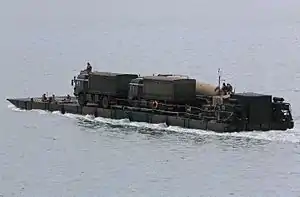
Mexeflote
Mexeflotes are amphibious landing craft operated by 17 Port and Maritime Regiment and 165 Port and Maritime Regiment, Royal Logistic Corps for amphibious operations and are designed to deliver both armoured vehicles and material from ship to shore. They are usually deployed on the 16,160 tonne Bay-class landing ships of the Royal Fleet Auxiliary. Mexeflote is a powered raft (two diesel engines), used to move goods and vehicles between ship and shore when a pier is not available. [253]
Combat Support Boat
Both the Royal Engineers and 17 Port and Maritime Regiment and 165 Port and Maritime Regiment, Royal Logistic Corps also make use of the Combat Support Boat since it is capable of being used to support bridging and amphibious operations as well as inland water patrolling and ship-to-shore resupply (it can carry 2 tonnes of cargo or 12 personnel) and diving operations. It is also relatively quick, with a top speed of 30 knots. [257]
Future equipment

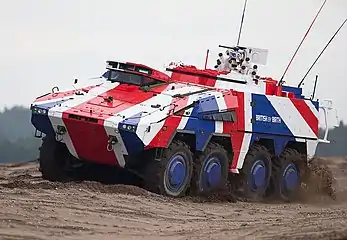
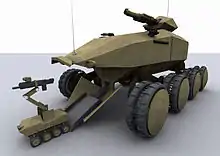
The British MoD released a Request for Information for the Mobile Fires Platform, a new 155mm self-propelled howitzer to equip the Royal Artillery and support the Armoured Infantry and Strike Brigades.[258]
A Prior Information Notice (PIN) was released for a successor to the Mobile Artillery Monitoring Battlefield Radar (MAMBA), Advanced Sound-ranging Post (ASP) and Counter-battery radar, all which will reach their out-out-service date in 2026.[259]
A Robotic Platoon Vehicle (RPV) was pitched at DSEI 2019.[260]
The Parachute Regiment began trialling the Sur-Ron Firefly electric motorcycle in 2021, "for recce, infiltration, but also for communications between positions where you need to pass messages on the man, like we’ve done for hundreds of years, but in a situation where electronic communication is jammed or intercepted. They’re quiet and quick enough that what would take a good couple of hours on foot would take less than half the time on a bike. You’re only going to win the battle quicker.”[261][262]
In March 2023, the first ever UK trial of heavy uncrewed ground systems (H-UGVs) took place. Held over two weeks at the Armoured Trials and Development Unit in Bovington, Dorset, the H-UGVs underwent stringent trials to test their effectiveness in battlefield situations. The trial saw three companies selected to take part to showcase their platforms: Elbit with its Robust, Milrem and its Type X, and Rheinmetall with its Wiesel. [263]
In March 2023, the 2nd Battalion, Royal Yorkshire Regiment trialled working with the Thermal Clip-On Sight, known as TCOS, which is mounted on their helmet. This allows infantry soldiers to see a combined thermal and night vision picture while undertaking activities rather than having to stop and look through a weapon sight. [264]
The Hydra 400 jet-propelled drone, which provides a maximum lift of 400kg and fires Brimstone laser-guided missiles, was showcased at DSEI 2023, and will be tested during the next phase of the Army’s Warfighting Experiment (AWE).[265]
At DSEI 2023, Raytheon UK announced that it's high-energy laser weapon system, a product of the MoD’s Land Demonstrator programme, is operationally ready and will be integrated onto a Wolfhound vehicle for testing in October 2023.[266] The 15-kilowatt laser will be used to stop aerial threats such as unmanned aerial vehicles. [267]
The British Army's future "broadband for the battlefield" is the Trinity Wide Area Network (WAN). Trinity, which is to be in service by late 2025, will be able to "handle 100 times more data than the current Falcon internet system", due to be retired by 2026. The Army also plans to fit Trinity nodes to the Boxer armoured vehicle.[268][269]
See also
- Other equipment lists
- List of communications and reconnaissance equipment of the British Army
- List of equipment of the Royal Marines
- Royal Engineers bridging and trackway equipment
- Unmanned systems of the British Army
- List of equipment of the RAF Regiment
- Related articles
References
- "Deployments". www.army.mod.uk. Retrieved 12 February 2020.
- "Defence Factsheet: Urgent Operational Requirements (UOR)". Ministry of Defence. Archived from the original on 27 March 2010. Retrieved 7 February 2010.
- "British Army Rifle Platoon (Current)".
- "Heart of the British Army: What is the Infantry made up of?". 10 July 2021.
- "SpecterOS™ 4X sight by Raytheon ELCAN selected for UK MoD FIST programme" (Press release). Raytheon ELCAN Optical Technologies. 10 September 2009. Archived from the original on 11 April 2011. Retrieved 11 April 2019.
- ""SHARPSHOOTER": THE UK'S NEW L129A1 7.62X51MM RIFLE". 2 October 2011.
- Ministry of Defence (17 January 2014). "New Army kit helps soldiers see more clearly". Gov.uk. Retrieved 11 April 2019.
- "Take a look at the Army's new infrared binoculars". 26 November 2022.
- "MilSight® S135 Magnum Universal Night Sight (MUNS)™".
- "Thales Awarded £150 million FIST order". 17 September 2009.
- "Personal weapons - Defence Equipment & Support".
- "Night Vision Devices". Elite UK Forces.info. Retrieved 26 August 2017.
- "eliteukforces - snipers".
- "L115A3: Is This British Sniper Rifle the Best In the World Today?". 7 May 2021.
- "UKSF Gear - Thermal Imagers".
- "How Does a Possible Javelin Lightweight Command Launch Unit Buy Fit with the UK's Long-term Anti-Tank Plans?". 5 August 2022.
- "Personal Role Radio". Ministry of Defence. Archived from the original on 27 January 2013. Retrieved 28 January 2010.
- "British Army - Personal Equipment - PRR".
- "Morpheus Programme: next generation tactical communication information systems for defence - GOV.UK". 18 April 2018.
- "Communication and Surveillance | The British Army".
- "Tactical Hearing Protection System (THPS) User Information" (PDF). Ministry of Defence. Archived from the original (PDF) on 14 October 2017. Retrieved 14 October 2017.
- "Service Inquiry - Death of a Soldier from a Gunshot Wound at Camp Taji, Iraq 2 January 2017" (PDF). assets.publishing.service.gov.uk. 19 June 2019. p. 58.
- "Glock 17". Ministry of Defence. Archived from the original on 1 July 2014. Retrieved 5 May 2014.
- Ministry of Defence (United Kingdom) (2014). Army Code No. 71996, DCC Training Volume II, Skill at Arms (Personal Weapons), General Service Pistol L131A1.
- "Service Inquiry Death of a Soldier from a Gunshot Wound at Camp Taji, Iraq 2 January 2017" (PDF). assets.publishing.service.gov.uk. 19 June 2019. p. 25.
- "New pistols for UK Armed Forces". Government of the United Kingdom and the Ministry of Defence. 11 January 2013.
- "Small arms and support weapons".
- "L22A2 Compact SA80".
- Steward, Oliver (5 January 2018). "L85A3: The rifle that refuses to give up". UK Defence Journal. Retrieved 11 April 2019.
- "British Army's rifle set for multi-million-pound upgrade". Ministry of Defence. 11 April 2018.
- Neville, Leigh (15 December 2016). The SAS 1983–2014. Osprey Publishing. p. 62. ISBN 9781472814036.
- Tanner, James (20 September 2014). The British Army since 2000. Osprey Publishing. p. 45. ISBN 9781782005933.
- Neville, Leigh (20 May 2015). The British Army in Afghanistan 2006–14: Task Force Helmand. Osprey Publishing. pp. 42–43. ISBN 9781472806758.
- Ministry of Defence (United Kingdom) (2012). "Royal Military Police train for close protection". Retrieved 20 June 2020.
- Corporal Adam J Wakefield, RLC (28 April 2021). "Project HERMOD 2". defenceimagery.mod.uk. Ministry of Defence. Retrieved 3 April 2023.
- LPhot Phil Bloor (16 March 2021). "40 Cdo-Project HERMOD Livex [MOD 45168192]". defenceimagery.mod.uk. Ministry of Defence. Retrieved 3 April 2023.
- LPhot Phil Bloor (17 March 2021). "40 Cdo-Project HERMOD LIVEX [MOD 45168238]". defenceimagery.mod.uk. Ministry of Defence. Retrieved 3 April 2023.
- "L119A2 – Colt Canada C8 Upgrade". Think Defence. 24 June 2014. Retrieved 26 August 2017.
- Neville, Leigh (2016). Guns of Special Forces 2001–2015. Barnsley: Pen & Sword Military. ISBN 978-1-47382-106-4.
- "L129A1 sharpshooter rifle". Ministry of Defence. Archived from the original on 20 June 2014. Retrieved 5 May 2014.
- "L129A1 (SSW) Rifle". RAF. Ministry of Defence. Archived from the original on 15 August 2017. Retrieved 14 October 2017.
- "New advanced rifle for Ranger Regiment". British Army. 7 September 2023. Retrieved 7 September 2023.
- "Knight's Stoner 1: British troops getting new assault rifle". Forces Network. 7 September 2023. Retrieved 7 September 2023.
- Kontis, George (24 August 2011). "Are We Forever Stuck with the Bayonet?". Small Arms Defense Journal. Retrieved 16 February 2020.
- Ministry of Defence (2004). Army Code No. 71807, Infantry Training Volume II, Pamphlet No. 5 The SA80 A2 (5.56 mm) System (Rifle, Light Support Weapon and Carbine) and Associated Equipment.
- Ministry of Defence (2015). Army Code No. 71807, Infantry Training Volume II, Pamphlet No. 5 The SA80 A2 (5.56 mm) System (Rifle, Light Support Weapon and Carbine) and Associated Equipment.
- ISTEC Services. "Bayonet Adaptor". Retrieved 7 April 2020.
- "The Kukri - Gurkhas". 26 March 2013.
- "L115A3 Long range 'sniper' rifle". Ministry of Defence. Archived from the original on 29 June 2014. Retrieved 5 May 2014.
- Charlie Gao (19 February 2021). "Meet the Five Best Sniper Rifles in Action Today". nationalinterest.org.
- "L115A3: The UK's Sniper System Improvement Program". defenseindustrydaily.com.
- "Accuracy International AX50". ilinkJapan. Archived from the original on 10 March 2018. Retrieved 9 March 2018.
- Gander, Terry (2006). Jane's Infantry Weapons 2006–2007. Jane's Information Group. p. 22. ISBN 0-7106-2755-6.
- Miller, David (2001). The Illustrated Directory of 20th Century Guns. London, UK: Salamander Books Ltd. ISBN 978-1-84065-245-1.
- Neville, Leigh (15 December 2016). The SAS 1983–2014. Osprey Publishing. p. 60. ISBN 9781472814036.
- Ministry of Defence (United Kingdom) (1998). Army Code No. 71611, Infantry Tactical Doctrine Volume 1, Pamphlet No. 1 Infantry Company Group Fundamentals.
- "Soldier Magazine September 2018". British Army. Retrieved 8 September 2018.
- "General Purpose Machine Gun". Ministry of Defence. Archived from the original on 25 January 2013. Retrieved 28 January 2010.
- Fiorenza, Nicholas (7 November 2019). "UK Boxer contract signed". Janes. Retrieved 3 April 2023.
- "Heavy machine gun". Ministry of Defence. Archived from the original on 27 January 2013. Retrieved 28 January 2010.
- Watt, Richard (23 June 2010). "Benelli M4 Combat Shotgun". defenceimagery.mod.uk. Ministry of Defence (United Kingdom). Retrieved 15 February 2023.
- "BENELLI L128A1" (PDF). Defence Equipment Sales Authority. 14 October 2021. Retrieved 16 February 2023.
- "Combat Shotgun". Ministry of Defence. Archived from the original on 27 January 2013. Retrieved 28 January 2010.
- "British SAS CT team during training making entry into a killing house using a 870 Remington magnum shotgun". 18 January 2021.
- "SAS Weapons Remington 870".
- Ministry of Defence (2009). Army Code No. 71882, Infantry Tactical Doctrine Volume 1, Pamphlet No. 3 Infantry Platoon Tactics.
- "SA80 individual weapon". Army.mod.uk. Archived from the original on 10 December 2015. Retrieved 22 April 2009.
- "The Infantry – Small Arms in the Section". British Army. Archived from the original on 27 December 2005. Retrieved 23 June 2020.
- "Leading system supplier of 40mm weapons, ammunition and fire control technology" (PDF). Rheinmetall Defence. 13 September 2011.
- Neville, Leigh (20 May 2015). The British Army in Afghanistan 2006–14: Task Force Helmand. Osprey Publishing. p. 54. ISBN 9781472806758.
- "Grenade Machine Gun". Ministry of Defence. Archived from the original on 27 January 2013. Retrieved 28 January 2010.
- Lance Cpl. Larisa Chavez (31 July 2019). "Agile Spirit 19: Close quarter battle range". DVIDS. Retrieved 4 April 2023.
- "L109A1 HE fragmentation grenade". Twitter.com. Retrieved 28 May 2021.
- BACTEC International Limited. "Potential Sources of Allied UXO" (PDF). WSP UK Limited. Archived from the original (PDF) on 22 June 2020. Retrieved 20 June 2020.
- Secretariat, Defence Equipment and Support (2 July 2019). "FOI2019/06669" (PDF). Whatdotheyknow. Retrieved 3 July 2019.
They have been replaced by the L84A3 red phosphorous (sic) smoke grenade
- "Spirco – Smoke hand grenade". Rheinmetall Defence. Retrieved 14 October 2017.
- "House of Commons Hansard Debates for 26 Jul 1993". publications.parliament.uk.
- "What Do Assault Pioneers Do? | Forces TV" – via www.youtube.com.
- Ministry of Defence (United Kingdom) (2012). "DIN Digest October 2012" (PDF). Retrieved 12 August 2018.
- Chemring Energetics UK (2018). "CEUK Demolition Stores Capability Brochure" (PDF). Retrieved 20 January 2020.
- Chemring Energetics UK (2016). "AP Bangalore Torpedo" (PDF). Retrieved 20 January 2020.
- Chemring Energetics UK (2011). "Advanced Performance Bangalore Torpedo" (PDF). Retrieved 20 January 2020.
- Chemring Energetics UK (2018). "CEUK Demolition Stores Capability Brochure" (PDF). Retrieved 20 January 2020.
New international regulations introducing taggants – microscopic identifiers – to the manufacturing process meant the UK MOD required a new generation of plastic explosive. The UK MOD identified that this was also the opportunity to replace its Second World War technology – where soldiers had to unwrap each stick of plastic explosive and, in many cases, tie them together – with a new product that was easier and quicker to use.
- "HEXOMAX is our new bulk plastic explosive". eurenco.com. 2013. Archived from the original on 23 August 2014.
- "Fast Cook off Test (FCO)" (PDF). ndiastorage.blob.core.usgovcloudapi.net. 2012. p. 14.
- "Picture of Demolition charge, Slab PE7, L21A1". cdn.globalauctionplatform.com.
- Ministry of Defence (United Kingdom) (2015). "DIN Digest January 2015" (PDF). Retrieved 10 February 2020.
- Chemring Energetics UK (2018). "CEUK Demolition Stores Capability Brochure" (PDF). Retrieved 20 January 2020.
- Chemring Energetics UK (2016). "PE8 Plastic Explosive" (PDF). Archived from the original (PDF) on 12 July 2020. Retrieved 18 July 2021.
- Ministry of Defence (United Kingdom) (1980). Army Code No. 60777 Pt.1, Mine A/Tank HE Blast L9 L17 & L18 (Barmine), General Arrangement & Sectioned View.
- Gordon, Michael R.; Trainor, Bernard E. (1995). The Generals' War. Little, Brown and Co. pp. 369-360. ISBN 0-316-32100-1.
- Cpl. Brian Gabriel Jr. (1 February 2011). "UK forces use explosives to save time, lives". DVIDS. Retrieved 5 September 2020.
- Chemring Energetics UK (2016). "Charge Demolition User Filled (Conical)" (PDF). Retrieved 16 June 2020.
- Chemring Energetics UK (2016). "Charge Demolition User Filled (Linear)" (PDF). Retrieved 16 June 2020.
- Mondial Defence Systems. "Charge Demolition Necklace L1A1" (PDF). Archived from the original (PDF) on 23 January 2014. Retrieved 16 June 2020.
- Chemring Energetics UK (2018). "CEUK Demolition Stores Capability Brochure" (PDF). Retrieved 20 January 2020.
- Chemring Group PLC. "Charge Demolition User Filled (CDUF) – Conical". Retrieved 14 August 2020.
- Chemring Group PLC. "Charge Demolition User Filled (CDUF) – Linear". Retrieved 14 August 2020.
- Cpl Daniel Wiepen RLC (Phot) (3 April 2016). "Exercise Shamel Storm 2016". defenceimagery.mod.uk. Ministry of Defence (United Kingdom). Retrieved 3 April 2023.
- Chemring Energetics UK (2016). "Charge Demolition Sheet Explosive SX4" (PDF). Retrieved 12 June 2020.
- "81mm Mortar". Ministry of Defence. Archived from the original on 7 March 2013. Retrieved 28 January 2010.
- "United Kingdom: British Army". armedforces.co.uk. Retrieved 11 April 2019.
- "The Rifles". Facebook.
- "L16 81mm Mortar". eliteukforces.info.
- "NLAW". Ministry of Defence. Archived from the original on 28 June 2014. Retrieved 5 May 2014.
- "UK orders thousands more anti-tank weapons to bolster stockpiles - A £229 million deal will see thousands of Next Generation Light Anti-Tank Weapon (NLAW) systems assembled in Northern Ireland and delivered to the British Army".
- "Javelin Medium Range Anti-tank Guided Weapon". Ministry of Defence. Archived from the original on 17 February 2013. Retrieved 28 January 2010.
- "Shoulder launch: more than ever, light, shoulder-launched weapons are proving their worth in built-up areas". Armada International. 1 August 2007. Retrieved 11 April 2019 – via TheFreeLibrary.com.
- Chuter, Andrew (30 March 2023). "Britain, NATO order Saab's Carl-Gustaf weapons". DefenseNews. Retrieved 3 April 2023.
- "British Military Weapons - ILAW Rocket Launcher". www.eliteukforces.info. Retrieved 2 April 2023.
- Kemp, Ian (April–May 2006). "The law gets tougher: the shoulder-launched light anti-armour weapon has evolved to become a multipurpose assault weapon much in demand for asymmetric warfare". Armada International. ISSN 0252-9793. Retrieved 11 April 2019 – via TheFreeLibrary.com.
- "The Infantry – Support Weapons". British Army. Archived from the original on 27 December 2005. Retrieved 23 June 2020.
- "Artillery and air defence". www.army.mod.uk. Retrieved 16 February 2020.
- "StarStreak - Thales Group".
- "Has Ukraine used British missile the UK Armed Forces has only just accessed?". Forces Network. 13 April 2022. Retrieved 2 April 2023.
- "Martlet ( Lightweight Multirole Missile) - Think Defence". www.thinkdefence.co.uk. 12 November 2022. Retrieved 2 April 2023.
- "New Virtus body armour for infantry troops". Ministry of Defence. Archived from the original on 18 September 2015. Retrieved 15 August 2015.
- "Revision to Supply State-of-the-Art Cobra Plus Head Protection System for UK Troops". Archived from the original on 26 September 2015. Retrieved 18 September 2015.
- "Combat body armour (2014)". Ministry of Defence. Archived from the original on 6 May 2014. Retrieved 6 May 2014.
- "Combat body armour (2016)". Ministry of Defence. Archived from the original on 1 June 2016. Retrieved 31 July 2020.
- "MOD Donnington donates thousands of helmets to Ukraine Military". April 2022.
- Ministry of Defence (2001). Army Code No. 71717, Infantry Training Volume 1, Pamphlet No. 2 Fieldcraft, Battle Lessons and Exercises.
- "The Infantry – Individual Equipment". British Army. Archived from the original on 27 December 2005. Retrieved 31 July 2020.
- "Operational use and regular deployment of the Enhanced Combat Body Armour ECBA" (PDF). assets.publishing.service.gov.uk. 28 September 2015.
- "MOD introduces pelvic protection for front line troops". gov.uk.
- "Pelvic Protection System". Archived from the original on 12 October 2012.
- "What military equipment has the UK sent to Ukraine?". forces.net. 25 May 2023.
- "309,228! Final respirator is handed over in £52 million contract" (PDF). Desider. No. 80. Ministry of Defence. 9 January 2015. Retrieved 9 January 2015.
- "Request for the latest JSP 786 defence clothing catalogue (Annex C) - s_1-6.pdf" (PDF).
- "New UK Forces Footwear – Brown Boots By Haix". Combat & Survival. 1 January 2013. Archived from the original on 5 March 2014.
- "Something for the Ladies – Alt-Berg's Female Lasts". Combat & Survival. 1 August 2013. Archived from the original on 29 January 2014.
- "Combat boots". Ministry of Defence. Archived from the original on 6 May 2014. Retrieved 6 May 2014.
- Ministry of Defence (23 July 2012). "Deal signed for new combat boots". Gov.uk. Retrieved 15 August 2015.
- "Aku Pilgrim GTX Boots".
- Marshall, Andrew (25 June 2018). "What is the Virtus Soldier System?". Boot Camp & Military Fitness Institute. Retrieved 15 September 2023.
- "UK Army Virtus Training Videos". Source Tactical Gear. Retrieved 15 September 2023.
- Tip 2 - MOLLE Belt. How to configure and wear the VIRTUS MOLLE Belt | British Army, retrieved 15 September 2023
- British Army Personal Kit - Layer 2: Fight!, retrieved 15 September 2023
- PO Phot Owen Cooban (17 May 2017). "British Assault Rifles". Ministry of Defence (United Kingdom). Retrieved 5 July 2023.
- Cpl Nathan Tanuku (19 November 2020). "SCOTS DG Go Paintballing". Ministry of Defence (United Kingdom). Retrieved 5 July 2023.
- Pfc. Destinee Rodriguez (30 July 2022). "US, UK and Bulgarian soldiers perform CQB Training during Platinum Lion '22". DVIDS. Retrieved 5 July 2023.
- "Personal clothing". Ministry of Defence. Archived from the original on 6 May 2014. Retrieved 6 May 2014.
- "Request for a copy of the virtus equipment book" (PDF). assets.publishing.service.gov.uk. 24 July 2018.
- Stuart A Hill AMS (7 June 2017). "Live Mortar Firing Exercise". defenceimagery.mod.uk. Ministry of Defence (United Kingdom). Retrieved 22 February 2023.
- Dawson, Cpl. Danielle (10 February 2021). "Army Reserves train for success - Ex YORKSHIRE STRIKE". defenceimagery.mod.uk. Ministry of Defence (United Kingdom). Retrieved 22 February 2023.
- Ministry of Defence (United Kingdom) (2015). Army Code No. 71717, Infantry Training Volume 1, Pamphlet No. 2 Fieldcraft, Battle Lessons and Exercises.
- "UK armed forces equipment and formations 2023". gov.uk. Ministry of Defence. 23 September 2023. Retrieved 23 September 2023.
- "Challenger 2 main battle tank". Ministry of Defence. Archived from the original on 28 June 2014. Retrieved 6 May 2014.
- "Integrated Review: Defence Command Paper". Parliament. 22 March 2021. Retrieved 8 April 2021.
- "Challenger 3 tanks reach next milestone - GOV.UK".
- "Challenger 3 main battle tank (MBT) will replace the Challenger 2 MBT in service with the British Army".
- "'Shambles' as £5.5bn armoured vehicle project is branded 'a complete and utter disaster'". express.co.uk. 12 December 2022. Retrieved 11 February 2023.
- "British Army - Ajax".
- "New 40mm cannon system handed over to British Army".
- "UK armed forces equipment".
- "UK details Boxer variants and confirms plans for bigger fleet". 17 June 2021.
- "Boxer For the British Army".
- "Production in West Midlands of British Army's new Boxer vehicle begins". 28 March 2023.
- "Soldier Magazine".
- "Warrior infantry fighting vehicle". Ministry of Defence. Archived from the original on 28 June 2014. Retrieved 6 May 2014.
- Chuter, Andrew (22 March 2021). "Who are the winners and losers in Britain's new defense review?". Defense News. Retrieved 8 April 2021.
- "100 extra Boxer vehicles for the British Army".
- "UK sells on more than 150 armoured vehicles in 2022". army-technology.com. 25 November 2022.
- "British Army - Bulldog & FV430 series". army.mod.uk.
- "Bulldog & FV430 series". Ministry of Defence. Archived from the original on 28 June 2014. Retrieved 6 May 2014.
- "Bulldog replacement yet to be determined - UKDJ". ukdefencejournal.org.uk. 7 January 2022.
- "Protected Patrol Vehicles - British Army".
- "Wolfhound". Ministry of Defence. Archived from the original on 6 May 2014. Retrieved 6 May 2014.
- "Mastiff". Ministry of Defence. Archived from the original on 29 June 2014. Retrieved 6 May 2014.
- "UK Decommissions Protected Patrol Vehicles". 15 July 2020.
- "Global Response Force tested on iconic Salisbury Plain". 11 May 2023.
- "Coyote / Jackal 2 TSV".
- "Coyote TSV (light)". Ministry of Defence. Archived from the original on 4 May 2014. Retrieved 6 May 2014.
- "Collaborative relationship will deliver major order with UK MOD for High Mobility Transporters - Babcock". 23 February 2023.
- "Foxhound". Ministry of Defence. Archived from the original on 6 May 2014. Retrieved 6 May 2014.
- "GeneralDynamics Foxhound".
- Philip Dunne, Minister for Defence Procurement (4 September 2013). "Written Answers: Defence: Armoured Fighting Vehicles". Parliamentary Debates (Hansard). House of Commons. col. 404W.
- "RWMIK Land Rover". Ministry of Defence. Archived from the original on 29 June 2014. Retrieved 6 May 2014.
- "Royal Yeomanry Receive Their First Jackal". YouTube.
- "British Army Equipment Summary". ArmedForces.co.uk. Retrieved 12 December 2016.
- Defence Equipment and Support. "Corporate Plan 2015–2018" (PDF). Gov.uk. p. 25. Retrieved 11 April 2019.
- "Supacat delivers upgraded British Army CBRN Vehicles". 22 September 2022.
- "L118 light gun". Ministry of Defence. Archived from the original on 29 June 2014. Retrieved 6 May 2014.
- "AS90 self-propelled gun". Ministry of Defence. Archived from the original on 28 June 2014. Retrieved 6 May 2014.
- "British Army announces new artillery deal with Sweden". GOV.UK. Retrieved 16 March 2023.
- Bisht, Inder Singh (16 March 2023). "British Army to Receive Swedish Archers as Interim Artillery Replacement: Report". The Defense Post. Retrieved 16 March 2023.
- "British Army announces new artillery deal with Sweden". GOV.UK. Retrieved 30 May 2023.
- "Upgrades to Multiple Launch Rocket Systems Strengthen Deep Fires Capability". British Army. 31 March 2021. Archived from the original on 1 April 2021. Retrieved 8 April 2021.
- "26th Regiment Royal Artillery". Ministry of Defence. Archived from the original on 4 April 2019. Retrieved 14 May 2019.
- "3 Regiment Royal Horse Artillery".
- "Sky Sabre Air Defence System".
- weapons defence industry military technology UK. "British army unveils its new Sky Sabre air defense missile system | weapons defence industry military technology UK | analysis focus army defence military industry army". Armyrecognition.com. Retrieved 28 May 2021.
- "16 Regiment RA - The British Army".
- "Multi-million pound contract awarded to secure life-saving weapon locating radar systems". Ministry of Defence. April 2020.
- "COBRA - COUNTER BATTERY RADAR - ADVANCED WEAPON LOCATING SYSTEM".
- "COBRA -". armedforces.co.uk.
- "Starstreak high velocity missile". Ministry of Defence. Archived from the original on 1 October 2017. Retrieved 26 August 2017.
- "12 Regiment Royal Artillery". army.mod.uk.
- "106 Yeomanry Regiment Royal Artillery".
- "Long-Range Precision Guided Weapons – The New Force Multiplier". 29 May 2018.
- "26th Regiment Royal Artillery is the Army's Divisional Fires Regiment. Equipped with the Multiple Launch Rocket System (MLRS) and EXACTOR 2, the new Regiment delivers precision strike munitions out to 84km in support of the Iron Division".
- "Trojan armoured vehicle". Ministry of Defence. Archived from the original on 6 May 2014. Retrieved 6 May 2014.
- "Armoured Engineer - British Army Roles - Royal Engineers".
- "Titan armoured bridge launcher". Ministry of Defence. Archived from the original on 6 May 2014. Retrieved 6 May 2014.
- "Terrier". Ministry of Defence. Archived from the original on 6 May 2014. Retrieved 6 May 2014.
- "Challenger armoured repair & recovery vehicle". Ministry of Defence. Archived from the original on 6 May 2014. Retrieved 6 May 2014.
- "Meet The Tanks And Other Armor The U.K. Is Sending To Ukraine". 16 January 2023.
- "Defence Secretary oral statement on war in Ukraine GOV.UK". 16 January 2023.
- "Recovery Mechanic Royal Electrical and Mechanical Engineers".
- "Heavy equipment transporter". Ministry of Defence. Archived from the original on 6 May 2014. Retrieved 6 May 2014.
- "British Army RLC Careers - Driver Tank Transporter Operator".
- Andrew Robathan, Minister for the Armed Forces (27 June 2012). "Written Answers: Armed Forces: Vehicles". Parliamentary Debates (Hansard). House of Commons. col. 266W.
- "Wheeled Tanker | Oshkosh Defense".
- "BR90 bridge family". Ministry of Defence. Archived from the original on 7 May 2014. Retrieved 6 May 2014.
- "M3 Amphibious bridging vehicle". Ministry of Defence. Archived from the original on 7 May 2014. Retrieved 6 May 2014.
- "Bridging nations with German and British engineers - British Army News".
- "Support vehicles". Ministry of Defence. Archived from the original on 6 May 2014. Retrieved 6 May 2014.
- "First battle-critical vehicles delivered to British Army" (PDF). DESider. No. 126. Ministry of Defence. January 2019. p. 7. Retrieved 11 April 2019.
- "Scotlands Logistic Regiment Train on EPLS Trucks". Facebook.
- "Logistic workhorse rolls out fleet fit for the future - British Army News".
- "Facebook - 104 Regiment Royal Artillery "Yesterday's Royal Gun Salute received exceptional support from the public. "". Facebook.
- "47 Regiment Royal Artillery Facebook". Facebook.
- "Land Rover Wolf 4×4 Military Vehicle".
- "Army Land Rovers in new trial of electric powered UK military vehicles". 14 April 2023.
- "Land Rover battlefield ambulance". Ministry of Defence. Archived from the original on 6 May 2014. Retrieved 6 May 2014.
- "British Army Explosive Ordnance Disposal (EOD) Engineering equipment".
- "British Army receives pioneering bomb disposal robots".
- "L3HARRIS T7 EOD". 30 July 2019.
- "L3Harris Technologies Delivers Final Explosive Ordnance Disposal Robot to UK Ministry of Defence for Project STARTER".
- "Next generation vehicle for EOD soldiers announced".
- "Marshall Land Systems delivers the first 10 EOD and ECM specialist vehicles to the UK Ministry of Defence".
- "11 EOD and Search Regiment".
- "Terex Demag to supply 65 cranes to UK army".
- "Amey and Briggs have linked up to deliver a £240 million contract to maintain and manage construction and materials-handling equipment used by British forces worldwide". 26 August 2021.
- "DE&S award contract for Defence construction and mechanical handling capability". 28 August 2020.
- "AmeyBriggs £240m MITER defence contract goes live". 26 August 2021.
- "AmeyBriggs.co.uk".
- "About Us - AmeyBriggs".
- "A year of supporting COVID response - BRITISH ARMY".
- "Supacat ATMP".
- "Quad Bike - British Army Website". Archived from the original on 6 May 2014.
- Connors, Shaun (9 April 2014). "Briefing: Wheels of the Elite". Jane's Defence Weekly. 51 (20). ISSN 0265-3818.
- "UKSF to evaluate General Dynamics' Flyer-72". Jane's International Defense Review. 47 (10). 1 October 2014.
- "New patrol vehicles will give troops enhanced capability". Ministry of Defence (Press release). 25 June 2007. Archived from the original on 29 June 2007.
- Dodd, Mark (14 May 2008). "Brits buy our army vehicles". The Australian. Archived from the original on 31 December 2012.
- Neville, Leigh (2011). Special Operations Patrol Vehicles: Afghanistan and Iraq. Oxford: Osprey Publishing. p. 42. ISBN 9781849081870.
- Neville, Leigh (2016). The SAS 1983-2014. Illustrated by Peter Dennis. London: Osprey Publishing. ISBN 9781472814050.
- Sommerville, Quentin (8 August 2016). "UK special forces pictured on the ground in Syria". BBC News. Retrieved 18 August 2016.
- "UK armed forces equipment and formations 2017". Ministry of Defence. HM Government. 2017. Retrieved 6 July 2017.
- "DESider" (PDF). No. 127. MoD. February 2019. Archived (PDF) from the original on 6 March 2019. Retrieved 4 March 2019.
{{cite magazine}}: Cite magazine requires|magazine=(help) - "New version of Apache attack helicopter enters service". UK Defence Journal. 23 January 2022.
- Perry, Dominic. "UK selects H135s to replace British Army's elderly Gazelle helicopters". Flight Global.
- "Know Your Army - Boats". 4 October 2021.
- "SAS Boat Troop - eliteukforces".
- Storm (WB41), Diablo (WB42), Mistral (WB43) and Sirocco (WB44)
- "UK Amphibious Capability". 16 May 2015.
- "Know Your Army - Boats". 4 October 2021.
- Turnbull, Grant (2 April 2019). "UK releases RFI for new self-propelled howitzer". IHS Jane's 360. Retrieved 3 April 2019.
- "United Kingdom-Bristol: Intelligence, surveillance, target acquisition and reconnaissance 2019/S 125-307119 Prior information notice for contracts in the field of defence and security Supplies". ted.europa.eu. Ted.Tenders.Electronic.Daily. 2 July 2019. Retrieved 3 July 2019.
The existing weapon locating capabilities: Mobile Artillery Monitoring Battlefield Radar (MAMBA), Advanced Sound-ranging Post (ASP) and the Lightweight Counter Mortar Radar (LCMR) reach their OSD in 2026.
- Rovery, Melanie (17 September 2019). "HIPPO Multipower pitches ATSV-E for British Army's RPV programme". IHS Janes. London. Retrieved 21 January 2020.
- "Army Parachute Regiment trial electric bikes".
- "Army Testing Electric Motorbikes for Military Airdrops". 27 December 2021.
- "UK's first ever trial of heavy uncrewed ground vehicles gives glimpse of future battlefield".
- "Infantry soldiers trial future of frontline warfare".
- Panasovskyi, Maksim. "The UK Army has unveiled the Hydra 400 drone, armed with three Brimstone missiles with a launch range of more than 30 km". gagadget.com. Retrieved 13 September 2023.
- "Raytheon UK to integrate laser weapon on patrol vehicle". optics.org. Retrieved 13 September 2023.
- Allison, George (13 September 2023). "Raytheon UK to integrate new UK laser weapon – DSEI23". Retrieved 13 September 2023.
- Newton, Simon (11 October 2023). "British Army and RAF's new 'broadband for the battlefield' explained". Forces Network. Retrieved 13 October 2023.
- "UK MOD awards £89m contract to boost battlefield communications | BAE Systems". www.baesystems.com. Retrieved 13 October 2023.
External links
- "The British Army: Vehicles and Equipment". Ministry of Defence.
- "Army Index". Armed Forces.co.uk.
- "British Special Forces & Elite Units". Elite UK Forces.
.jpg.webp)


.jpg.webp)
.jpg.webp)



.jpg.webp)